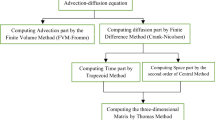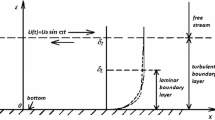Abstract
Several important aspects on the modeling of bottom boundary layer dynamics and cohesive sediment dynamics are scrutinized in detail. Various bottom boundary layer models are reviewed and example results presented. Models of sediment erosion and deposition are discussed. A rigorous deposition model, formulated based on fundamental fluid-mechanical considerations, can be used to improve understanding of erosion-deposition processes and to reduce uncertainties contained in empirical erosion model. Formulation of a flocculation model is discussed by considering the interactions between turbulent eddies and sediment particles. Examples are drawn from a recent study on the dispersion of cohesive sediments in the Mississippi Sound.
Access this chapter
Tax calculation will be finalised at checkout
Purchases are for personal use only
Preview
Unable to display preview. Download preview PDF.
Similar content being viewed by others
References
Ariathurai, R. O., and Arulanandan, K., “Erosion of Cohesive Soils,” Journal of Hydraulics Division, ASCE, Vol. 104, No. HY2, 1978, pp. 279–283
Bagnold, R. A., “Motion of Waves in Shallow Water. Interaction between Waves and Sand Bottoms,” Proceedings of Royal Society, A187, 1946, pp. 1–15.
Bakker, W. T., “Bottom Friction and Velocity Distribution in an Oscillatory Flow,” Rijkswaterstaat, Dir, Hydr. Res. & Water Management, Dept. Coastal Res., Memo 73–23, 1973.
Bakker, W. T., and Van Doom, Th., “Near Bottom Velocities in Waves with a Current,” Proceedings of 16th International Conference on Coastal Engineering, 1978.
Batchelor, G. K., “The Application of the Similarity Theory of Turbulence to Atmospheric Diffusion,” Quarterly J. Roy., Metero., Sci., Vol. 76, 1950, 133.
Brevik, I., “Oscillatory Rough Turbulent Boundary Layers,” Journal of Waterways, Port, Coastal and Ocean Division, ASCE, Vol. 107, 1981, pp. 175–188.
Brevik, I. and Aas, B., “Flume Experiments on Waves and Currents, 1, Rippled Bed,” Coastal Engineering, Vol. 3, 1980, pp. 149–177.
Businger, J. A., Wyngoard, J. C., Izumi, Y., and Bradley, E. F., “Flux-Profile Relationships in the Atmosphereic Surface Layer,” J. Atmos. Sci., Vol. 28, 1971, pp. 181–189.
Christensen, R. W., and Das, B. M., “Hydraulic Erosion of Remolded Cohesive Soils,” in “Soil Erosion: Causes and Mechanics, Prevention and Control,” Special Report 135, Highway Research Board, Washington, D.C., 1973, pp. 52–74.
DuToit C. G., and Sleath, J. F. A., “Velocity Measurements Close to Rippled Beds in Oscillatory Flow,” Journal of Fluid Mechanics, Vol. 112, 1981, pp. 71–96.
Einstein, H. A., and Krone, R. B., “Experiments to Determine Modes of Cohesive Sediment Transport in Salt Water,” Journal of Geophysical Research, Vol. 67, 1962, pp. 1451–1461.
Feke, D. L., and Schowalter, W. R., “The Effect of Brownian Diffusion on Shear- Induced Coagulation of Colloidal Dispersions,” Journal of Fluid Mechanics, Vol. 133, 1983, pp. 17–35.
Frielander, S. K., Smoke, Dust and Haze, Fundamentals of Aerosol Behavior, Wiley-Interscience, New York, 1977, 317 pp.
Fukuda, M., “Entrainment of Cohesive Sediments in Fresh Water,” Ph.D. Dissertation, Case Western Reserve University, 1979.
Grant, W. D., and Madsen, O. S., “Bottom Friction Under Waves in the Presence of a Weak Current,” NOAA Tech Report, ERL-MESA, 1978; 150 pp.
Grant, W. D., and Madsen, O. S., “Combined Wave and Current Interaction with a Rough Bottom,” Journal of Geophysical Research, Vol. 84, 1979, pp. 1797–1808.
Grant, W. D., Williams, III, A. J., and Glenn, S. M., “Bottom Stress Estimates and their Prediction on the Northern California Continental Shelf during CODE-1: The Importance of Wave-Current Interaction,” Journal of Physical Oceanography, Vol. 14, 1984, pp. 506–527.
Gust, C., “A Discussion of Bottom Stress Estimates and their Prediction on the Northern California Continental Shelf during C0DE-1: The Importance of Wave- Current Interaction,” Journal of Physical Oceanography, Vol. 14, 1984.
Gust, G., “The Benthic Boundary Layer,” in Oceanography, Landolt-Börnstein (new series) V/3, 1982, Chap. 8.5 (J. Sünderman, Ed.), Springer Verlag, Berlin.
Hunt, J. R., “Self-similar Particle-Size Distributions During Coagulation: Theory and Experimental Verification,” Journal of Fluid Mechanics, Vol. 122, 1982, pp. 169–185.
Jonsson, I. G., and Carlsen, N. A., “Experimental and Theoretical Investiga¬tions in an Oscillatory Rough Turbulent Bounday Layer,” Journal of Hydraulic Research, Vol. 14, 1976, pp. 45–60.
Jonsson, I. G., “A New Approach to Oscillatory Rough Turbulent Boundary Layers,” Ocean Engineering, Vol. I, 1980, pp. 109–152.
Kajiura, K., “A Model of the Bottom Boundary Layer in Water Waves,” Bull. Earthq. Res. Inst., Vol. 46, 1968, pp. 75–123.
Kalkanis, G., “Turbulent Flow Near an Oscillatory Wall,” U.S. Army B.E.B. Techn Memo, 1957.
Kemp, P. H., and Simons, R. R., “The Interaction Between Waves and a Turbulent Current: Waves Propagating with the Current,” Journal of Fluid Mechanics, Vol. 116, 1982, pp. 227–250.
Krone, R. B., “Flume Studies of the Transport of Sediment in Estuarial Shoaling Processes,” Contract Report, U.S. Army Corps of Engineers, San Francisco District, 1962.
Krone, R. B., “Engineering Interest in the Benthic Boundary Layer,” in The Benthic Boundary Layer, ( I. N. McCave, Ed.), Plenum Press, New York, 1976, pp. 143–156.
Lane, D. D., and Stukel, J. J., “Aerosol Deposition on a Flat Plate,” Journal of Aerosol Science, Vol. 9, 1978, pp. 191–197.
Lewellen, W. S., and Teske, M. E., “Prediction of the Monin-Obukhov Similarity Functions from an Invariant Model of Turbulence,” J. Atmos. Sci., Vol. 30, 1973, pp. 1340–1345.
Lewellen, W. S., and Sheng, Y. P., “Modeling of Dry Deposition of SO2 and Sulfate Aerosols,” Report EPRI EA-1452, Electric Power Research Institute, Palo Alton, CA, 1980.
MacPherson, H., “The Attenuation of Water Waves Over a Non-Rigid Bed,” Journal of Fluid Mechanics, Vol. 97, 4, 1980, pp. 721–742.
McCave, I. N., “Erosion Transport and Deposition of Fine-Grained Marine Sediments,” in Fine-Gained Sediment: Deep-Water Processes and Facies, (D. A. V. Stow and D. J. W. Diper, Eds.), Blackwell Scientific Pubs., London, 1984.
Mehta, A. J., and Partheniades, E., “Kaolinite Resuspension Properties,” Journal of Hydraulics Division, ASCE, Vol. 105, No. HY4, 1979, pp. 411–416.
Mehta, A. J., “Review of Erosion Function for Cohesive Sediment Beds,” Proceeding of First Indian Conference on Coastal Engineering, Madras, India, 1981, pp. 1–122 to 1–130.
Mehta, A. J., Parchure, T. M., Dixit, J. G., and Ariathurai, R., “Resuspension Potential of Deposited Cohesive Sediment Beds,” in Estuarine Comparisons, (V. S. Kennedy, Ed.), Academic Press, New York, 1982, pp. 591–609.
Owen, M. W., “Erosion of Avonmouth Mud,” Hydraulic Research Station Report, Int. 78, 1974, 25 pp.
Parchure, T. M., “Effect of Bed Shear Stress on the Erosional Characteristics of Kaolinite,” Technical Report, University of Florida, 1980.
Partheniades, E., “A Study of Erosion and Deposition of Cohesive Soils in Salt Water,” Ph.D. Dissertation, University of California, Berkeley, 1962.
Pearson, H. J., Valioulis, I. A., and List, E. J., “Monte Carlo Simulation of Coagulation in Discrete Particle-Size Distributions, Part 1. Brownian Motion and Fluid Shearing,” Journal of Fluid Mechanics, Vol. 143, 1984, pp. 367–385.
Saffman, P. G., and Turner, J. S., “On the Collision of Drops in Turbulent Clouds,” Journal of Fluid Mechanics, Vol. 1, 1956, pp. 16–30.
Sargunam, A., Riley, P., Arulanandan, K. and Krone, R. B., “Physico-Chemical Factors in Erosion of Cohesive Soils,” Journal of Hydraulic Division, ASCE, Vol. 99, (HY3), 1973, pp. 555–558.
Sehmel, G. A., “Particle Eddy Diffusivities and Deposition Velocities for Isothermal Flow and Smooth Surfaces,” Journal of Aerosol Science, Vol. 4, 1973, pp. 125–138.
Sheng, Y. P., and Lick, W., “The Transport and Resuspension of Sediments in a Shallow Lake,” Journal of Geophysical Research, Vol. 84, 1979, pp. 1809–1826.
Sheng, Y. P., “Modelling Sediment Transport in a Shallow Lake,” in Estuarine and Wetland Processes, ( P. Hamilton and K. B. McDonald, Eds.), Plenum Publishing Corp., N.Y., 1980, pp. 299–337.
Sheng, Y. P., “Hydraulic Applications of a Second-Order Closure Model of Turbulent Transport,” in Applying Research to Hydraulic Practice, (P. Smith, Ed. ), ASCE, 1982, pp. 106–119.
Sheng, Y. P., and Butler, H. L., “Modeling Coastal Currents and Sediment Dispersion,” Proceedings of 18th International Conference on Coastal Engineering, ASCE/Capetown, S.A., 1982, pp. 1127–1148.
Sheng, Y. P., “Mathematical Modeling of Three-Dimensional Coastal Currents and Sediment Dispersion,” Technical Report CERC-83-2, U.S. Army Corps of Engineers Waterways Experiment Station, CE, Vicksburg, MS, 1983, Also A.R.A.P. Report No. 458, Princeton, NJ, 288 pp.
Sheng, Y. P., “A Turbulent Transport Model of Coastal Processes,” Proceedings of 19th International Conference on Coastal Engineering, ASCE/Houston, TX, 1984, pp. 2380–2396.
Sheng, Y. P., “Numerical Computation of Current- and Wave-Induced Erosional Forcing within the Humboldt Bay,” A.R.A.P. Techn. Memo #84-18, Princeton, NJ, 1984a.
Sleath, J. F. A., “Velocities Above a Rough Bed in Oscillatory Flow,” Proceedings ASCE, Journal of Waterways, Harbors and Coastal Engineering Division, Vol. 100 (WW4), 1974, pp. 287–304.
Smoluchowski, M. von, “Versuch einer mathematischen Theorie der koajulationskinetik kolloider lö Z. Phys. Chem., p2, 1918, pp. 129–168.
Taylor, G. I., “Statistical Theory of Turbulence,” Proceedings of Royal Society, Seris A, Vol. 151, 1935, pp. 421–478.
Thorn, M. F. C., and Parsons, J. G., “Erosion of Cohesive Sediments in Estuaries: An Engineering Guide,” in Third International Symposium on Dredging Technology, British Hydraulics Research Association, 1980, pp. 349–358,
Trowbridge, J. and Madsen, O. S., “Turbulent Wave Boundary Layers,” Journal of Geophysical Research, Vol. 89, 1984; pp. 7989–8007.
Valioulis, I. A., List, E. J., and Pearson, H. J., “Monte Carlo Simulation of Coagulation in Discrete Particle-Size Distributions, Part 2, Interparticle Forces and the Quasi-Stationary Equilibrium Hypothesis,” Journal of Fluid Mechanics, Vol. 143, 1984, pp. 387–411.
van Hoften, J. D. A., and Karaki, S., “Interaction of Waves and a Turbulent Current,” Proceedings of 15th International Conference on Coastal Engineering, 1976.
Author information
Authors and Affiliations
Editor information
Editors and Affiliations
Rights and permissions
Copyright information
© 1986 Springer-Verlag New York, Inc.
About this paper
Cite this paper
Sheng, Y.P. (1986). Modeling Bottom Boundary Layer and Cohesive Sediment Dynamics in Estuarine and Coastal Waters. In: Mehta, A.J. (eds) Estuarine Cohesive Sediment Dynamics. Lecture Notes on Coastal and Estuarine Studies, vol 14. Springer, New York, NY. https://doi.org/10.1007/978-1-4612-4936-8_17
Download citation
DOI: https://doi.org/10.1007/978-1-4612-4936-8_17
Publisher Name: Springer, New York, NY
Print ISBN: 978-0-387-96296-2
Online ISBN: 978-1-4612-4936-8
eBook Packages: Springer Book Archive




